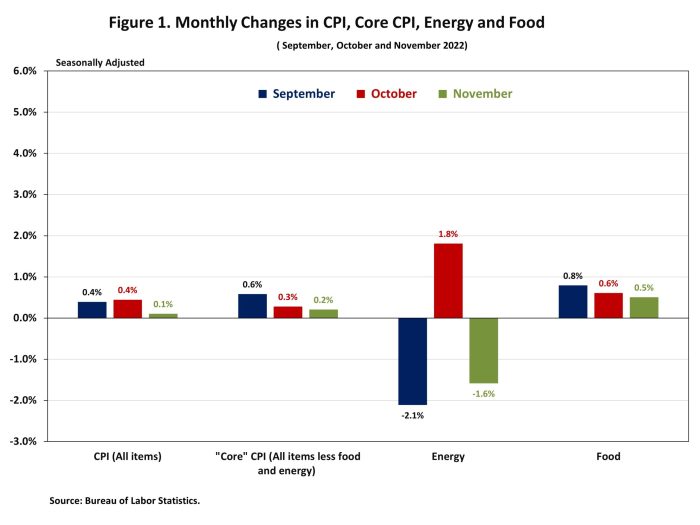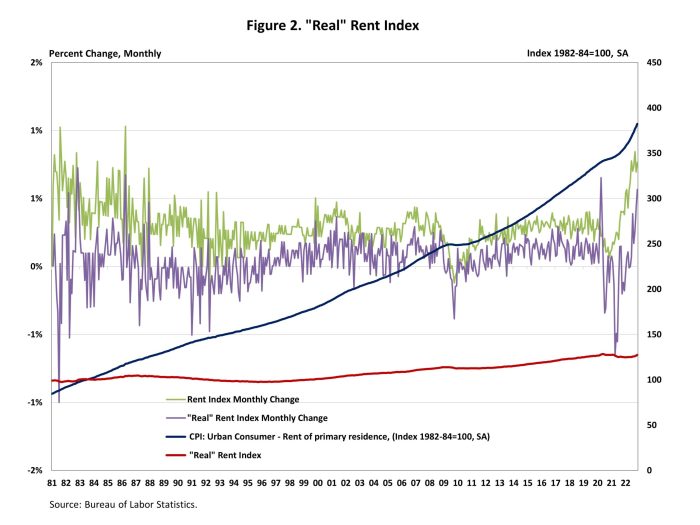Inflation Continues to Cool in November
BY FAN-YU KUO
DECEMBER 13, 2022
Consumer prices in November saw the smallest year-over-year gain since December 2021.While still elevated, inflation experienced the second month below an 8% annual growth rate since February 2022. However, the shelter index continued to rise at an accelerated pace and was more than offsetting decreases in energy indexes. Shelter inflation will primarily be cooled in the future via additional housing supply. As inflation appears to have peaked and continues to slow, this may ease some of pressure on the Fed to maintain a more aggressive monetary policy.
The Bureau of Labor Statistics (BLS) reported that the Consumer Price Index (CPI) rose by 0.1% in November on a seasonally adjusted basis, following an increase of 0.4% in October. The price index for a broad set of energy sources fell by 1.6% in November as the gasoline index (-2.0%), the natural gas index (-3.5%) and the electricity index (-0.2%) all declined. Excluding the volatile food and energy components, the “core” CPI increased by 0.2% in November, following an increase of 0.3% in October. This is the smallest monthly increase since August 2021. Meanwhile, the food index increased by 0.5% in November with the food at home index also rising 0.5%.
Most component indexes continued to increase in October. The indexes for shelter (+0.6%), communication (+1.0%), recreation (+0.5%), motor vehicle insurance (+0.9%), education (+0.3%) as well as personal care (+0.7%) showed sizeable monthly increases in November. Meanwhile, the indexes for used cars and trucks (-2.9%), medical care (-0.5%) and airline fares (-3.0%) declined in November.
The index for shelter, which makes up more than 40% of the “core” CPI, rose by 0.6% in November, following an increase of 0.8% in October. The indexes for owners’ equivalent rent (OER) increased by 0.7% and rent of primary residence (RPR) increased by 0.8% over the month. Monthly increases in OER have averaged 0.7% over the last three months. More cost increases are coming from this category, which will maintain pressure on inflationary forces in the months ahead. These higher costs are driven by lack of supply and higher development costs. Higher interest rates will not slow these costs, which means the Fed’s tools are limited in addressing shelter inflation.
During the past twelve months, on a not seasonally adjusted basis, the CPI rose by 7.1% in November, following an 7.7% increase in October. The “core” CPI increased by 6.0% over the past twelve months, following a 6.3% increase in October. The food index rose by 10.6% and the energy index climbed by 13.1% over the past twelve months.
NAHB constructs a “real” rent index to indicate whether inflation in rents is faster or slower than overall inflation. It provides insight into the supply and demand conditions for rental housing. When inflation in rents is rising faster (slower) than overall inflation, the real rent index rises (declines). The real rent index is calculated by dividing the price index for rent by the core CPI (to exclude the volatile food and energy components).
The Real Rent Index rose by 0.6% in November. Over the first eleven months of 2022, the monthly change of the Real Rent Index increased by 0.2%, on average.

